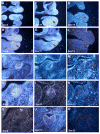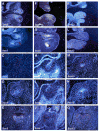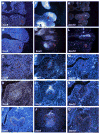Expression of Sox genes in tooth development
- PMID: 26864488
- PMCID: PMC5292047
- DOI: 10.1387/ijdb.150192ao
Expression of Sox genes in tooth development
Abstract
Members of the Sox gene family play roles in many biological processes including organogenesis. We carried out comparative in situ hybridization analysis of seventeen sox genes (Sox1-14, 17, 18, 21) during murine odontogenesis from the epithelial thickening to the cytodifferentiation stages. Localized expression of five Sox genes (Sox6, 9, 13, 14 and 21) was observed in tooth bud epithelium. Sox13 showed restricted expression in the primary enamel knots. At the early bell stage, three Sox genes (Sox8, 11, 17 and 21) were expressed in pre-ameloblasts, whereas two others (Sox5 and 18) showed expression in odontoblasts. Sox genes thus showed a dynamic spatio-temporal expression during tooth development.
Figures






Similar articles
-
Regulation of CCN2 gene expression and possible roles in developing tooth germs.Arch Oral Biol. 2013 Nov;58(11):1659-66. doi: 10.1016/j.archoralbio.2013.08.010. Epub 2013 Aug 31. Arch Oral Biol. 2013. PMID: 24112732
-
Spatio-temporal expression of Sox genes in murine palatogenesis.Gene Expr Patterns. 2016 Jul;21(2):111-8. doi: 10.1016/j.gep.2016.05.002. Epub 2016 May 27. Gene Expr Patterns. 2016. PMID: 27241892
-
Slit1 is specifically expressed in the primary and secondary enamel knots during molar tooth cusp formation.Mech Dev. 2001 Sep;107(1-2):155-7. doi: 10.1016/s0925-4773(01)00454-3. Mech Dev. 2001. PMID: 11520671
-
Enamel knots as signaling centers linking tooth morphogenesis and odontoblast differentiation.Adv Dent Res. 2001 Aug;15:14-8. doi: 10.1177/08959374010150010401. Adv Dent Res. 2001. PMID: 12640732 Review.
-
Novel role of the SRY-related high-mobility-group box D gene in cancer.Semin Cancer Biol. 2020 Dec;67(Pt 1):83-90. doi: 10.1016/j.semcancer.2019.07.011. Epub 2019 Jul 26. Semin Cancer Biol. 2020. PMID: 31356865 Review.
Cited by
-
Identification of a novel de novo mutation in SOX4 for syndromic tooth agenesis.Clin Oral Investig. 2024 Apr 30;28(5):287. doi: 10.1007/s00784-024-05659-6. Clin Oral Investig. 2024. PMID: 38684576
-
Cleft Candidate Genes and Their Products in Human Unilateral Cleft Lip Tissue.Diseases. 2021 Apr 7;9(2):26. doi: 10.3390/diseases9020026. Diseases. 2021. PMID: 33917041 Free PMC article.
-
Depression and Antidepressants During Pregnancy: Craniofacial Defects Due to Stem/Progenitor Cell Deregulation Mediated by Serotonin.Front Cell Dev Biol. 2021 Aug 12;9:632766. doi: 10.3389/fcell.2021.632766. eCollection 2021. Front Cell Dev Biol. 2021. PMID: 34476233 Free PMC article. Review.
-
Missense variants weakening a SOX9 phosphodegron linked to odontogenesis defects, scoliosis, and other skeletal features.HGG Adv. 2025 Apr 10;6(2):100404. doi: 10.1016/j.xhgg.2025.100404. Epub 2025 Jan 10. HGG Adv. 2025. PMID: 39797402 Free PMC article.
-
Dental characteristics of patients with four different types of skeletal dysplasias.Clin Oral Investig. 2023 Oct;27(10):5827-5839. doi: 10.1007/s00784-023-05194-w. Epub 2023 Aug 7. Clin Oral Investig. 2023. PMID: 37548766 Free PMC article.
References
-
- ANDL T, AHN K, KAIRO A, CHU EY, WINE-LEE L, REDDY ST, CROFT NJ, CEBRA-THOMAS JA, METZGER D, CHAMBON P, LYONS KM, MISHINA Y, SEYKORA JT, CRENSHAW EB, 3RD, MILLAR SE. Epithelial Bmpr1a regulates differentiation and proliferation in postnatal hair follicles and is essential for tooth development. Development. 2004;31:2257–2268. - PubMed
-
- CHIMAL-MONROY J, RODRIGUEZ-LEON J, MONTERO JA, GAÑAN Y, MACIAS D, MERINO R, HURLE JM. Analysis of the molecular cascade responsible for mesodermal limb chondrogenesis: Sox genes and BMP signaling. Dev Biol. 2003;257:292–301. - PubMed
-
- FERGUSON CA, TUCKER AS, SHARPE PT. Temporospatial cell interactions regulating mandibular and maxillary arch patterning. Development. 2000;127:403–412. - PubMed
-
- FUKUMOTO S1, YAMADA A, NONAKA K, YAMADA Y. Essential roles of ameloblastin in maintaining ameloblast differentiation and enamel formation. Cells Tissues Organs. 2005;181:189–195. - PubMed
Publication types
MeSH terms
Substances
Grants and funding
LinkOut - more resources
Full Text Sources
Other Literature Sources
Molecular Biology Databases
Miscellaneous

